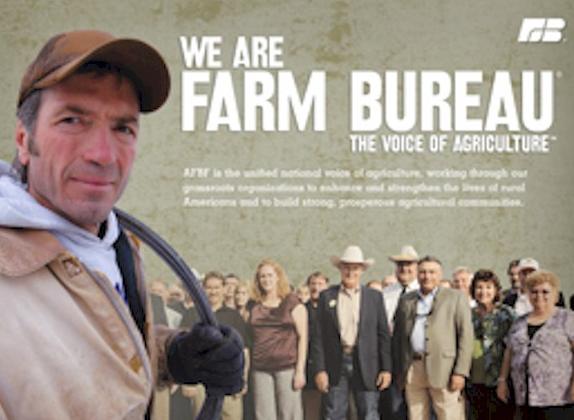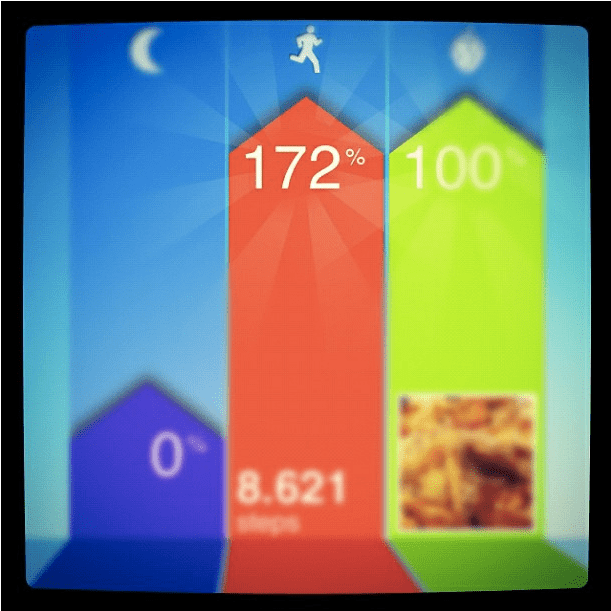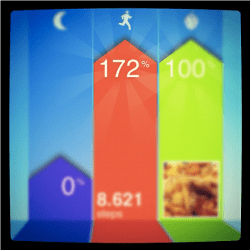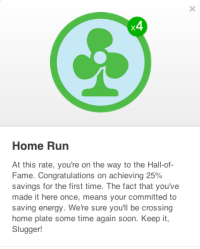
Big Fan: Simple Energy rewards power-conscious consumers with unlockable achievements. Click to embiggen.
At any given moment, Collin Faunce can see exactly how much energy he’s using in his house. When he turns on the dishwasher, his consumption spikes on the colorful head-up display on his computer monitor. If he and his wife, Erica, set the air conditioning just a few degrees higher, they can watch the dollars spared tick upwards in real time. They don’t have to wait for the monthly bill to understand their savings, and when a gadget siphons away precious energy, the Faunces can immediately identify the culprit.
“After about a week or two [of using the program], I could figure out which appliances were using how much energy and kind of plan accordingly after that,” said Faunce.
Welcome to our gamified future: where energy efficiency competes with Foursquare and Angry Birds for your attention. Winning brings badges and high scores, but it also translates into money saved for the consumer and a smarter grid for everyone.
The Faunces got the display last year when they entered a program hosted by San Diego Gas & Electric (SDG&E) to encourage people to cut down on energy consumption. The utility partnered with Boulder, Colo.-based startup Simple Energy to motivate residents by making a competitive game out of it, complete with prizes.
“You could tell what position you were in relative to everyone else — you could determine if you were going to catch them and pass them,” said Faunce.
Simple Energy develops websites and apps that allow consumers to track their energy usage in real time and compete with each other (or themselves) to reduce it. The contest the Faunces won, Biggest Energy Saver, was actually a pilot program in San Diego that proved social gaming applications can help consumers earn an average energy savings of 20 percent — up to 50 percent for top users.
But the energy and cost savings didn’t end when the competition did. “People thought we were going to revert back, but we’re actually saving more and more as time goes on,” Faunce said.
Here’s an oversimplified description of how it works: Simple Energy gets consumer usage data from electric utilities and funnels that through its servers into the mobile and desktop programs it designs. All you need is a computer or smartphone: Once you sign up, your online account or mobile phone app can tell you how much energy you’ve used in the last hour, day, month, etc.
“You don’t actually have to do anything — other than save energy,” said Simple Energy co-founder and CEO Yoav Lurie. “Even if you never come back, you’re still playing.”
If your friends join, you can monitor how you’ve performed against them, too. If you’re using less energy, you’ll score more points and beat them out. As a reward, you can earn badges (a la Foursquare) for reaching certain benchmarks or demonstrating feats of energy-saving skill: How often can you halve your energy use? For how many days in a row?
Lurie thinks the concept is a no-brainer. He points to people struggling to stay healthy: We all know what health-positive habits are good for us, but does everyone get enough exercise and eat right all the time? Both research and anecdotal evidence back up the idea that competition — be it a points system to control your eating habits or finding a workout buddy — make long-term health goals easier to attain. It’s the same with energy efficiency: A lot of people think it’s a good idea to save more energy, it’s just inconvenient or a hassle to do so.
“We’ve always relied on gamification,” Lurie said. “Now it’s just getting more complicated.”
Lurie says utilities nationwide are eager to work with Simple Energy: Some have state-mandated efficiency goals to meet, while others hope to combat energy-use spikes that imperil the stability of the grid, leading to brownouts and blackouts that neither customers nor utilities want to suffer through. So it’s in the utilities’ interest to figure out how they can effectively encourage customers to reduce their energy use and try especially hard to cut back on high-demand days (common in the current nationwide inferno we call “summer 2012”).
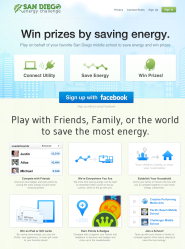
Eyes on the prize: Some utilities reward ultra-efficient consumers with iPads or cash grants for nearby schools. Click to embiggen.
Some utilities already promote efficiency directly to customers in messages printed on monthly bills, but those aren’t exactly game-changing tactics. Behavioral change requires an effective communication to an engaged audience, and let’s face it: Nobody wants to spend more time talking with their utility than they have to.
“Most utilities don’t have a mechanism for telling customers to lower their A/C,” said Lurie. “Who follows their utility on Twitter?”
This summer, SDG&E enlisted Simple Energy to run the San Diego Energy Challenge: Residents can compete in reducing their energy use to win prizes like gift cards and tablet computers. But the biggest winner will be local schools: When residents sign up for the contest (which is jointly funded by SDG&E and the U.S. Department of Energy) they choose a middle school to earn points for. In the end, the three middle schools with the greatest savings will split a $30,000 cash grant.
Erin Coller, SDG&E communications manager, said while the company runs its own programs promoting efficiency, Simple Energy’s approach is good at getting people actually excited about it.
“It’s not something that’s really top of mind on a regular basis,” she said. The networking and gaming platforms really “increase the level of enthusiasm that people have about their energy use.”
Simple Energy (which also has a program with beleaguered Pepco in the D.C. area) is not the only company using social networking and gamification to promote energy efficiency.
This spring, Opower launched a Facebook app to let friends compare their energy use. Both companies are integrating Green Button data, an industry-led initiative (albeit at the request of the White House) launched in March to increase consumers’ access to data about their own energy use. Using it involves clicking an actual “green button” on utilities’ websites.
Green buttons are hardly riveting, but other energy efficiency startups are employing more distinctive and even whimsical approaches. Leafully, the Grand Prize winner in the DOE’s Apps for Energy challenge, translates energy consumption into carbon impact units anyone can relate to: number of trees purifying the air or number of farting cows in a month, for example. The idea is to make it easy for anyone, regardless of age or maturity level, to understand and have fun with energy consumption.
Gamification is quite the buzzword these days, so is this all a passing fad? It’s possible. But for Simple Energy and potentially Opower, gamification seems like the easiest way to get people to do something they already want to do (use less energy) using tools they’re already excited about (Games. Virtual badges. Facebook!). Nothing more, nothing less.
Simple Energy, now 18 months old, thinks they’ll get it to a point where people in different cities, and under different utilities, can engage and compete with each other. (Right now, you can only compete against others who share your service area.) There are a few obstacles between here and there: How do you create an even playing field across different climate zones, or how will you handicap players with access to abundant hydropower?
Still, cross-country competitions could come sooner rather than later. Lurie said they’ve already spoken with hundreds of utilities who are waiting to see how their current partnerships turn out. “The need is great,” he says.
Coller said it’s too soon to tell if SDG&E will continue or expand their program after this summer, but she made it clear that Simple Energy is a valuable part of the efficiency equation.
And if other users react like the Faunces have, there’s no doubt it can have an impact on individual habits. Faunce doesn’t see his grandparents enrolling in a Simple Energy program, but for people open to new technology, he thinks it’s an easy sell.
“People are competitive and we’re competitive — it’s kind of what helped us win,” he said. And victory brings much more than bragging rights: Since starting the program, the Faunces have saved nearly $2,000 a year on energy costs. With results like that, it’s not hard to imagine everyone wanting to play.
